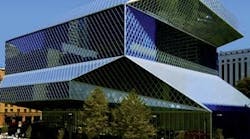The building envelope is the skin that surrounds a building, providing protection for the structure, interiors, and occupants from the degrading elements of nature. Protection may also be provided against manmade events, such as vandalism, bomb blasts, etc. The building façade includes the vertical elements of the building envelope, and horizontal and sloping surfaces can be included in the façade as well. On a new building, the cost of the building envelope is generally 20 to 25 percent of the total building cost, and can be higher if certain design criteria is met, such as storm or blast resistance. Statistics show that more than 50 percent of construction litigation is related to envelope deficiencies.
Executives at large commercial development and realty firms have indicated that there are two things most problematic in providing a beneficial environment for the building occupants: balanced, uniform, and comfortable HVAC, and airtight and watertight building envelopes. If these aren’t made right during construction, they’re not easily corrected throughout the life of the building.
Why do we experience envelope failures? One or more of the following may be the root cause(s): inadequate design and/or contract language, faulty materials and/or workmanship, deterioration, etc. Deterioration can be expected over time, with the life-cycle being linked to the type and quality of the materials used (i.e. EIFS’ shorter life vs. granite’s longer life). The lowest initial cost often isn’t the best option, and "value engineering" may not truly add value. A project team starts in an auspicious manner by stipulating appropriate and thorough performance criteria in the contract documents, offering a thought-out path to success.
Referencing Technical Standards
There are more than 600 ASTM documents (technical standards, test methods, etc.) that provide criteria for design, testing, manufacture, and installation of materials and assemblies that make up the building envelope. In addition, there are numerous technical standards from other standards development organizations, such as ANSI, AISI, AAMA, DOE, GANA, etc., many of which are vital to effective quality assurance and quality control practices.
By understanding, utilizing, and referencing the appropriate technical standards and criteria contained therein, project teams will acquire a firm grasp of the contracted work, and will be better equipped to evaluate trade contractor "exclusions and qualifications" and "value engineering" proposals, product submittals, and work put into place.
Construction, renovation, or repair shouldn’t be executed without referencing and utilizing the appropriate codes and standards, and the criteria contained therein. For example, there are more than 600 ASTM documents (standards, test methods, etc.) that provide criteria for design, testing, manufacture, and installation of materials and assemblies that make up the building envelope. When used correctly, these documents and technical content are drawn upon to further define the requirements and criteria for design, construction, renovation, or repair.
On forensic assignments, the original specifications often contain mistakes or exclusions that are found to have a direct relationship with the failures being examined. Frequently, the appropriate criteria and referenced standards were unknown, misunderstood, or overlooked and not properly incorporated therein.
By utilizing the appropriate standards relative to building envelope constructions, project teams will have a firm grasp of the contracted work, and will be enabled to better understand contractor "exclusions and qualifications" and "value engineering" proposals. With knowledge and preparation during the design phase of new construction, reconstruction, or repairs, your building envelope and façade will likely have the integrity for a lasting life of service.
Mark Coulis is a senior design consultant at Wheaton & Sprague Engineering Inc. (www.wheatonsprague.com), located in Stow, OH.


